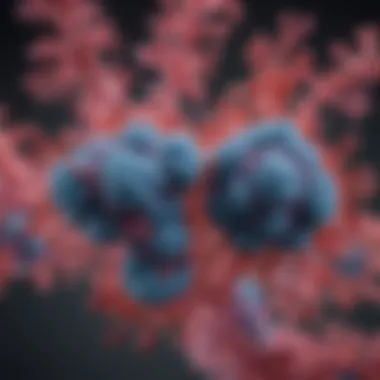Understanding the Mechanism of Action of PARP Inhibitors


Intro
The exploration of cancer treatment options has led to the recognition of PARP inhibitors as a particularly promising class of medication, especially in cases involving BRCA mutations. Using these inhibitors, practitioners can leverage a unique biochemical mechanism that exploits the weaknesses of cancer cells. This article will dissect the mechanism of action of PARP inhibitors, revealing the significance of poly(ADP-ribose) polymerase in DNA repair and its implications for targeted therapy.
Research Overview
Key Findings
Recent studies solidify our understanding of PARP inhibitors as effective agents in disrupting the DNA repair mechanisms of cancer cells. The main findings suggest that:
- PARP inhibitors block the activity of poly(ADP-ribose) polymerase, preventing the repair of single-strand breaks in DNA.
- Cancer cells with BRCA mutations are particularly sensitive to these inhibitors. When used in conjunction with traditional therapies, PARP inhibitors can enhance treatment efficacy.
- Evidence indicates that the combination of PARP inhibitors with other therapies may yield significant synergistic effects, further improving patient outcomes.
Study Methodology
The primary method employed in studying PARP inhibitors involves clinical trials and laboratory experiments. Researchers look at:
- Patient response rates to various PARP inhibitor treatments, collecting data from multiple cancer types.
- Biochemical assays that analyze the efficacy of PARP inhibitors in cell lines with specific genetic vulnerabilities.
- Cohort studies assessing the long-term outcomes in patients receiving PARP inhibitors as a part of their treatment regimens.
Background and Context
Historical Background
The discovery of PARP as a critical enzyme in the DNA damage repair pathway dates back to the late 20th century. Since then, extensive research has been conducted to understand its role in cellular processes and cancer biology. The development of PARP inhibitors began in earnest after the identification of BRCA1 and BRCA2 as key players in DNA repair, leading to an innovative therapeutic approach.
Current Trends in the Field
Currently, PARP inhibitors are at the forefront of targeted cancer therapies. The following trends are notable:
- Ongoing clinical trials assessing new PARP inhibitors with improved specificity and reduced side effects.
- Expanded use of PARP inhibitors in treating cancers beyond breast and ovarian, such as prostate and pancreatic.
- Increased interest in combining PARP inhibitors with immunotherapy and other modalities to enhance treatment effectiveness.
"Understanding the unique mechanism of PARP inhibitors opens up new avenues for targeted therapies, potentially revolutionizing treatment protocols for many cancer patients."
In summary, PARP inhibitors represent a significant advancement in the fight against cancer. Through their targeted approach and interaction with specific genetic mutations, they not only enhance existing therapies but also pave the way for innovative treatment strategies. The ongoing research in this area promises to deliver even more effective options for patients in the future.
Preface to PARP Inhibitors
In recent years, the emergence of PARP inhibitors has significantly changed the landscape of cancer treatment. These agents target specific vulnerabilities in tumors, particularly those associated with defective DNA repair mechanisms. Understanding PARP inhibitors not only illuminates their role in therapy but also sheds light on the broader implications for precision medicine. The advent of these drugs has provided clinicians with a new arsenal in the fight against cancer, specifically in treating patients with BRCA1 and BRCA2 mutations. Overall, grasping the nuances of PARP inhibitors is vital for educators, researchers, and healthcare professionals aiming to optimize cancer treatment strategies.
Definition of PARP Inhibitors
Poly(ADP-ribose) polymerase (PARP) inhibitors are a class of drugs designed to block the activity of PARP, an important enzyme in the DNA repair process. PARP enzymes play a crucial role in recognizing and repairing single-strand breaks in DNA. When PARP is inhibited, the repair of these breaks is hampered, leading to the accumulation of DNA damage, especially in cells that already have deficient repair capabilities. This accumulation can ultimately result in cellular death, which is particularly effective in cancer cells that rely on PARP for survival.
The therapeutic administration of PARP inhibitors can be particularly lethal to cancer cells harboring mutations in the BRCA genes, which are key players in the homologous recombination repair pathway.
Historical Context


The development of PARP inhibitors is rooted in foundational cancer biology research. The concept of targeting DNA repair mechanisms can be traced back several decades but gained momentum with the discovery of the BRCA genes in the 1990s. Scientists recognized that mutations in these genes severely impair the body's ability to repair DNA and that tumors harboring such mutations may be more susceptible to therapies that compound their DNA repair deficiencies.
In 2005, the initial PARP inhibitor, AZD2281 (also known as Olaparib), entered clinical trials. Subsequent trials demonstrated promising results, particularly in patients with BRCA-mutant tumors. Following these studies, the FDA approved Olaparib in 2014 for patients with recurrent ovarian cancer. This was a landmark moment, setting the stage for the approval of additional PARP inhibitors such as Niraparib, Rucaparib, and Talazoparib, each offering unique therapeutic options for patients.
Current FDA-Approved PARP Inhibitors
As of now, several PARP inhibitors have received FDA approval, each targeting different tumor types and offering distinct patient benefits. The primary PARP inhibitors currently approved include:
- Olaparib (Lynparza): Initially approved for ovarian cancer, it has since expanded indications, including breast and pancreatic cancers.
- Niraparib (Zejula): Often prescribed after chemotherapy for ovarian cancer, Niraparib enhances progression-free survival in patients.
- Rucaparib (Rubraca): Approved for patients with BRCA mutations, it provides an option for those with recurrent ovarian and prostate cancers.
- Talazoparib (Talzenna): Known for its potency, it is particularly useful in breast cancer treatment among patients with germline BRCA mutations.
Each of these PARP inhibitors exemplifies the shift towards targeted therapies in oncology, which emphasize precision and personalized treatment strategies.
Biochemical Mechanisms of Action
Understanding the biochemical mechanisms of action of PARP inhibitors is critical to grasping their role in cancer therapy. PARP inhibitors target specific cellular pathways that amplify the impact of DNA damage. These mechanisms influence treatment effectiveness, particularly in tumor types with underlying genetic vulnerabilities, such as BRCA mutations. Furthermore, elucidating these actions aids researchers and clinicians in developing strategies to optimize therapy and minimize adverse effects.
Role of Poly(ADP-Ribose) Polymerase in Cellular Repair
Poly(ADP-Ribose) polymerase, or PARP, is an essential enzyme involved in cellular repair processes. When DNA damage occurs, PARP detects and responds to the lesion. It adds poly(ADP-ribose) chains to target proteins, recruiting other repair factors to the site of damage. This activity expedites the repair process, ensuring genomic stability.
Inhibiting PARP can disrupt this repair mechanism. When PARP is inhibited, the repair of single-strand breaks is impaired. This leads to the accumulation of additional damage, eventually resulting in cell death, especially in cancer cells where the repair mechanisms are already compromised.
DNA Damage Repair Pathways
DNA damage can occur through various ways, such as environmental factors or normal cellular processes. Cells have evolved multiple pathways to repair DNA damage, including base excision repair, nucleotide excision repair, and double-strand break repair. PARP is primarily involved in the base excision repair pathway, addressing non-helix-distorting damage.
The interplay between these repair pathways is complex. When one pathway is dysfunctional, others can sometimes compensate. However, in certain cancer cells, particularly those with BRCA mutations, the homologous recombination pathway is often defective. This forms a critical context wherein PARP inhibitors can be especially advantageous, as they exploit the existing vulnerabilities in these cancer cells.
Interaction with Homologous Recombination
Homologous recombination (HR) is a precise DNA repair mechanism that repairs double-strand breaks accurately. This pathway is particularly relevant in cells with BRCA1 or BRCA2 mutations. These mutations compromise HR and impair efficient DNA repair. In such contexts, the introduction of PARP inhibitors becomes a vital strategy.
The concept of synthetic lethality is fundamental here. In BRCA-mutated tumors, cells can survive through HR disruption but become dependent on the PARP-mediated repair mechanism. When treated with PARP inhibitors, the cells can no longer cope with DNA damage, leading to cell death.
In summary, the biochemical mechanisms underlying the action of PARP inhibitors represent a blend of repair inhibition and exploitation of cancer cell vulnerabilities. Understanding these interactions lays the groundwork for advancements in targeted cancer therapies and paves the way for future innovations in treatment protocols.
Mechanism of Action of PARP Inhibitors
Understanding the mechanism of action of PARP inhibitors is crucial in comprehending their role in modern cancer treatment. These inhibitors target the cellular repair systems that are pivotal in maintaining genomic stability. By disrupting the actions of poly(ADP-ribose) polymerase enzymes, PARP inhibitors create a unique therapeutic effect, particularly relevant for tumors with existing DNA repair deficiencies. This section explores the essential elements of their action, the benefits they provide, and key considerations for their usage in oncology.
Inhibition of PARP Enzymatic Activity
The inhibition of PARP enzymatic activity is one of the primary mechanisms through which PARP inhibitors exert their effects. Poly(ADP-ribose) polymerase plays an essential role in detecting and repairing single-strand breaks in DNA. When PARP is inhibited, this process is disrupted, leading to an accumulation of DNA damage that the cell cannot repair. Over time, this leads to cellular stress and ultimately cell death, especially in cancer cells that already have compromised repair capabilities. This importance cannot be overstated; it changes the landscape of targeted therapies against specific cancer types.
Synthetic Lethality Explained
Definition of Synthetic Lethality


Synthetic lethality occurs when the simultaneous mutation of two genes leads to cell death, whereas mutation of either gene individually does not. In the context of PARP inhibitors, the concept applies when cells deficient in homologous recombination repair, such as those mutated in BRCA1 or BRCA2, are simultaneously exposed to PARP inhibition. The key characteristic here is that this mechanism specifically targets cancer cells with pre-existing vulnerabilities while sparing healthy cells. This selectivity represents a significant advantage for cancer therapies.
Examples in Cancer Therapy
In practice, synthetic lethality is applied extensively in cancer therapy, primarily for treating ovarian and breast cancers with BRCA mutations. Agents like Olaparib, Niraparib, and Rucaparib have demonstrated efficacy in this setting, greatly improving patient outcomes. The unique feature of these PARP inhibitors is their capacity to exploit the inherent weaknesses of certain tumors, leading to more effective and less toxic treatment options. As research progresses, the potential for combination strategies using synthetic lethality continues to rise, enhancing the landscape of cancer treatment.
Consequences of PARP Inhibition
The consequences of PARP inhibition are far-reaching. The inhibition leads to significant cellular apoptosis, particularly in tumor cells with pre-existing DNA errors. As previously mentioned, this mechanism also highlights the therapeutic window where healthy cells are less affected. Additionally, the use of PARP inhibitors can induce other collateral effects within cellular pathways, altering tumor microenvironments and influencing immune responses. This aspect not only enriches treatment modalities but also presents further opportunities for combination with immunotherapy and other systemic approaches.
Clinical Implications
The clinical implications of PARP inhibitors are profound in the landscape of oncology. Their application not only exemplifies targeted therapy but also emphasizes the relevance of precision medicine. This section delves into how these inhibitors have reshaped treatment, particularly for cancers associated with genetic mutations.
PARP Inhibitors in Oncology
PARP inhibitors serve as a cornerstone in treating various cancers, most notably breast and ovarian cancers associated with BRCA mutations. Their ability to exploit specific genetic weaknesses in tumor cells speaks to their targeted therapeutic approach. These inhibitors effectively prevent cancer cells from repairing DNA damage, ultimately leading to cell death. This mechanism has rendered them a compelling option, particularly for patients who demonstrate mutations in DNA repair genes. In addition to their primary roles, research is expanding the horizons for different cancers, paving the way for advancements in personalized therapies.
Impact on BRCA1 and BRCA2 Mutated Tumors
The impact of PARP inhibitors on BRCA1 and BRCA2 mutated tumors cannot be overstated. Patients with these mutations carry an inherent deficiency in DNA repair, making them uniquely susceptible to therapies that exploit this vulnerability. By inhibiting PARP, these drugs amplify the synthetic lethality effect, primarily affecting only those cells with dysfunctional repair pathways. As a result, clinical trials have shown promising responses in patients with BRCA mutations, contributing to improved survival rates and progression-free survival. This advantage substantiates the rationale for genetic testing in cancer patients, ensuring that those who can benefit most from PARP inhibitors are identified and treated accordingly.
Combination Therapies with PARP Inhibitors
The evolution of combination therapies involving PARP inhibitors is an area of growing interest. These strategies are designed to enhance the efficacy of existing treatments and broaden their application in diverse oncology settings.
Chemotherapy
Chemotherapy, historically a mainstay in cancer treatments, can gain enhanced effectiveness when combined with PARP inhibitors. The key characteristic of this combination lies in their synergistic effect on tumor cells. Chemotherapy induces DNA damage, while PARP inhibitors disable the repair mechanisms. This dual strategy creates a more substantial cytotoxic effect on cancer cells. However, while chemotherapy can increase treatment efficacy, it also bears potential drawbacks, including toxicity and side effects that can limit patient tolerance. Understanding this balance is crucial in optimizing treatment regimens.
Immunotherapy
Immunotherapy represents another promising avenue for combination with PARP inhibitors. This approach leverages the body's immune system to target cancer cells more effectively. One significant aspect of immunotherapy is its ability to generate a long-lasting immune memory against cancer cells. The unique feature of combining PARP inhibitors with immunotherapy lies in the potential for enhanced tumor immunogenicity. The inclusion of PARP inhibitors may improve the effectiveness of immune checkpoint inhibitors, thus fostering a more robust anti-tumor response. However, careful consideration must be given to the timing and sequence of administration to maximize patient outcomes without incurring excessive toxicity.
The intersection of precision medicine and combination therapies signifies a new era in oncological treatment, where tailored approaches are reshaping patient care.
Challenges and Limitations
The examination of PARP inhibitors presents both exciting opportunities and significant challenges within cancer treatment. While these inhibitors have revolutionized care for specific cancer types, particularly those associated with BRCA mutations, their application is not without limitations. Understanding these challenges is crucial for clinicians, researchers, and patients as they navigate the evolving landscape of cancer therapy.
Resistance Mechanisms to PARP Inhibitors
Resistance to PARP inhibitors can arise through multiple pathways. Certain tumors may develop secondary mutations that restore homologous recombination (HR) function, undermining the very foundations of synthetic lethality these drugs rely upon. Additionally, tumors might enhance drug efflux systems, reducing intracellular concentrations of the inhibitors. In some cases, alterations in PARP expression can also contribute to resistance.
Moreover, key mutations in genes such as RAD51 and BRCA2 can allow cancer cells to evade the effects of PARP inhibition. Understanding these mechanisms is essential for improving treatment outcomes. Researchers aim to develop combination therapies that can counteract these resistance mechanisms, making it an active area of research.


Patient Selection and Biomarkers
Optimizing patient selection plays a critical role in the efficacy of PARP inhibitors. Currently, genetic testing is necessary to identify patients with BRCA1 and BRCA2 mutations. However, the precision of these tests can vary. Biomarkers for identifying patients most likely to benefit from PARP inhibition are still in the developmental stage. This remains a barrier to universal application of these medications.
The need for precise patient stratification is paramount, as it may influence clinical decisions and outcomes. Future research seeks to identify additional biomarkers, such as ATM or PALB2 mutations, that could predict response or resistance to treatment.
Toxicities and Side Effects
Like any therapeutic intervention, PARP inhibitors may cause adverse effects. Common toxicities include nausea, fatigue, and anemia, which can impact the patient's quality of life and treatment adherence. In some instances, patients might also experience more severe complications, such as myelodysplastic syndromes or acute myeloid leukemia.
Monitoring for side effects is critical, ensuring that patients receive comprehensive care during treatment.
Future Perspectives
The field of PARP inhibitors is continually evolving, making the exploration of future perspectives essential. This section discusses various components, potential benefits, and key considerations regarding the advancement of PARP inhibitors and their application in cancer therapy.
Development of Next-Generation PARP Inhibitors
Next-generation PARP inhibitors are being developed with improved efficacy and fewer side effects compared to existing options like Olaparib and Niraparib. These novel compounds aim for better specificity in targeting tumors with DNA repair deficiencies, particularly those associated with BRCA mutations. The focus on improving pharmacokinetic properties and enhancing oral bioavailability is important.
Early clinical trials are showing promise in exploring compounds that can overcome the mechanisms of resistance seen in some patients. An example is the development of dual-target inhibitors that not only inhibit PARP but also engage other pathways concurrently. This could potentially enhance therapeutic outcomes by hitting multiple targets within the cancer cell's defense mechanisms.
Research Trends in PARP Inhibition
Research on PARP inhibition is shifting towards understanding biological mechanisms and patient responses. Studies are increasingly focused on identifying biomarkers that predict responses to therapy, which can guide treatment strategies.
Additionally, the integration of genomics and personalized medicine is becoming paramount. By understanding the unique genetic makeup of tumors, researchers aim to design better therapeutic interventions tailored to individual patients. This trend underscores the necessity for collaboration between geneticists, oncologists, and pharmacologists to advance treatment development.
Expanding Clinical Applications
The clinical applications of PARP inhibitors are expanding beyond BRCA-mutated cancers. For instance, there is ongoing investigation into their use in treating ovarian, prostate, and pancreatic cancers, even in patients without BRCA mutations. The rationale is based on the concept of synthetic lethality, which can apply to various tumor types with specific genomic alterations.
"The development of PARP inhibitors has opened new avenues in targeted cancer therapies, suggesting a future where treatment is personalized and more effective."
Also, combination therapies are gaining traction. Pairing PARP inhibitors with immunotherapy or other chemotherapy regimens shows potential to enhance overall effectiveness and combat resistance in tumors. Thus, through ongoing research and development efforts, the role of PARP inhibitors in cancer therapy is poised to broaden, offering improved outcomes for a wider array of patients.
The End
The conclusion serves as a pivotal element in understanding the overall impact and significance of PARP inhibitors in cancer therapy. It represents a synthesis of critical concepts discussed throughout the article, reinforcing the intricate connection between biochemical mechanisms and therapeutic applications. Recognizing the role of PARP inhibitors helps delineate targeted strategies for managing cancers, particularly those involving specific genetic mutations such as BRCA1 and BRCA2.
Summary of Key Points
In this article, we have established several significant points regarding PARP inhibitors:
- Mechanism of Action: Understanding how these inhibitors interfere with poly(ADP-ribose) polymerase activity and their contributions to DNA repair pathways.
- Therapeutic Implications: Their effectiveness in the treatment of cancer, especially in tumors with deficient homologous recombination repair capabilities.
- Uses in Combination Therapies: Exploring how PARP inhibitors can enhance the effects of other treatment modalities like chemotherapy and immunotherapy.
- Future Perspectives: The potential for next-generation PARP inhibitors and their expanded applications in oncology.
This summary encapsulates the essential takeaways that highlight the critical nature of PARP inhibitors in modern cancer treatment.
Final Thoughts on PARP Inhibitors
PARP inhibitors continue to revolutionize the landscape of cancer therapy. As we delve deeper into their mechanisms and applications, it is paramount to acknowledge both their potential and limitations. Continued research will be necessary to overcome resistance mechanisms and to identify appropriate biomarkers for patient selection.
The future of PARP inhibition appears promising, with advancements aiming to enhance efficacy and broaden the scope of their therapeutic use. Understanding these inhibitors in detail is crucial for healthcare professionals who strive for personalized treatment strategies in oncology. As the field evolves, remaining informed about the nuances of PARP inhibitors will facilitate better outcomes for patients afflicted by resistant cancer forms.







